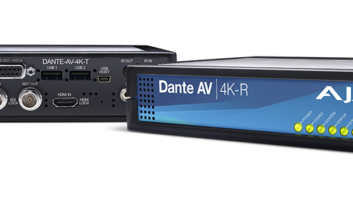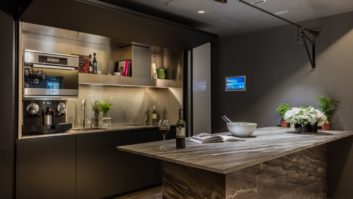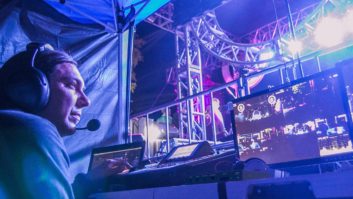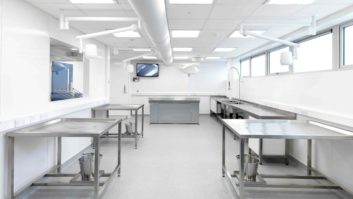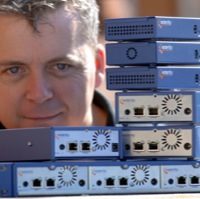
Having previously looked at the implementation of AVoIP in corporate environments, before moving onto control rooms; Michael Burns concludes by considering education and sporting applications.
Education is an area where AVoIP is making major inroads.
“AVoIP will change the way we educate, as it allows for collaborative learning on a school-wide level,” says Aurora Multimedia CEO, Paul Harris. The company’s 4K video and Dante audio capable technology, IPBaseT, makes it possible to page not only school-wide or to a zone but to an individual classroom. Other applications for the technology include using low-cost cameras to transmit any event through the system to the rest of the school or district, allowing displays and cameras to double up as alarm and emergency systems, and aid asset management by tracking the status of connected devices.
Another application common to this and other AVoIP technologies is two-way collaboration across the campus.
“Some colleges like to use a centralised switching topology in a building to allow all the lectures halls to share information back and forth,” says Michael Crisci, business development manager AV/IP and strategic alliances, Atlona. “Using a system like OmniStream enables them to build a matrix that suits their specific I/O requirements. When they need to, they can add additional input and outputs that are not constrained by the frame size of the traditional matrix. This saves money by using the current network as well as allowing for cost-effective upgrades.”
Crisci says overflow rooms offer another interesting application. “Large assemblies, such as graduations, typically require additional space to accommodate audiences,” he explains. “Using the network is an easy way to extend live, real-time video to other locations on a campus.”
Stadiums and sports
“Sports venues are the home of live events, and are likely to utilise a large number of displays to create a user experience around the facility,” states Crisci. “The native virtual matrix features of multicast IP solutions allows the sharing of any amount of source content to any number of displays. Therefore, it is possible to tailor the event content to specific zones in the facility.”
Crisci says ultra-low-latency benefits of AVoIP technology are perfect for these live events, where signal latency would degrade the user experience. “Venues can distribute the game or event throughout the facility without a delay, meaning that action happens on the screen as it happens inside the bowl. Low latency ensures that fans can see the action at the same time as those in the stands.”
“The main issues have been solved concerning image quality and latency,” agrees Paul Harris. “Aurora has not only focused on image quality and latency but using our transceiver concept we have simplified, serviceability and installation.”
Harris sees a steady move to AVoIP everywhere in this sector. “Currently it is all about educating AV dealers about the use of AV over IP and best practices,” he says. “Many have already transitioned, seeing this is the way the industry is going.”
There has also been extensive use of Cabletime technology within stadium installations. Mark Stanborough, sales manager, EMEA & APAC at Cabletime, says growth in this market has been not just to distribute TV and live feeds of matches and games, but also for digital signage. “This is being used for advertising and so providing a lucrative revenue stream,” he adds. “This has had a very important benefit over and above the [AVoIP] core function, allowing stadiums to increase ROI.”
Shared solutions
The lesson for AV pros from all these sectors is that the IT manager is your friend, not your rival.
“The ability to focus management and support of systems onto the IT network is a major underlying advantage of AVoIP,” says Michael Crisci. “We can make systems with greater ROI for the end-user by reducing costs associated with AV-specific tasks like switching, cabling infrastructure, conduit, pathway and storage. We now utilise the existing data infrastructure to support our AV distribution, and simplify system needs in the process.”
Case study: Oculus fitted with 16K videowall
The Oculus, the £19 million flagship teaching and learning building at the University of Warwick, is benefitting from cutting-edge AVoIP technology from tvONE.
Designed as the university’s first completely dedicated teaching structure, The Oculus boasts two auditoriums, 12 state-of-the-art flexible teaching spaces, and a number of social learning and net-work spaces.
On entering, visitors are greeted by a stunning four-screen 16K resolution videowall with a range of art displays, timetables of upcoming activity in the building and live streams of lectures and other events in the main lecture theatres as well as acting as the building dashboard.
Installed by GV Multimedia, the wall consists of four NEC X981UHD 4K panels arranged in portrait orientation, with content supplied by five ONELAN 4K players via a tvONE CORIOmaster C3-540 video wall processor.
“The videowall in the entrance area is our showcase for what is happening in the University,” says Ian Mason, AV analyst at the University of Warwick. “It can be used for anything from promoting departmental events and sporting successes, to streaming graduation ceremonies and the annual Coventry vs Warwick Varsity match. The tvONE CORIOmaster has given us unique flexibility – we can use each screen as an individual display, or combine all four into one massive, and hugely impressive, 16K resolution show screen.”
